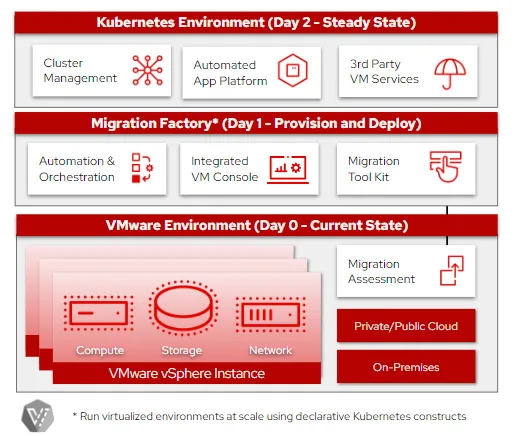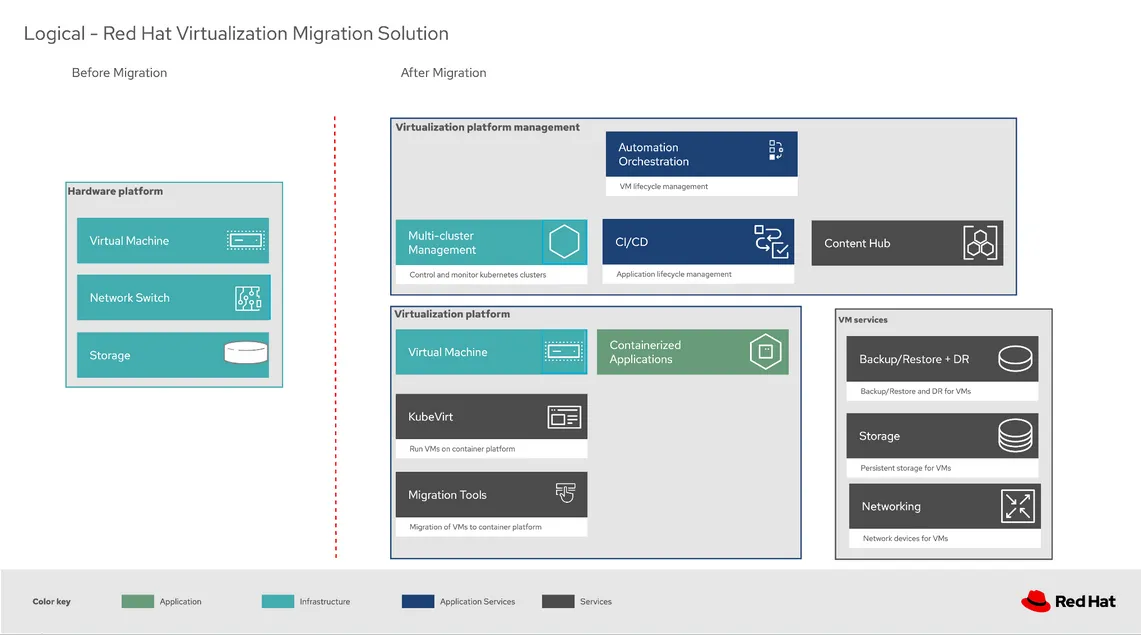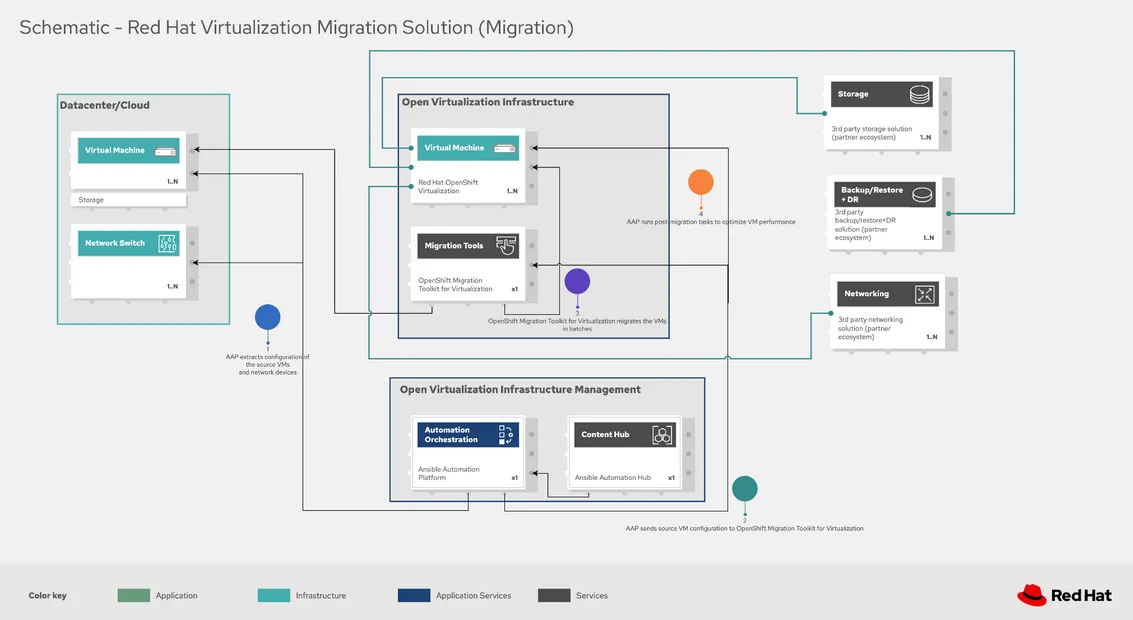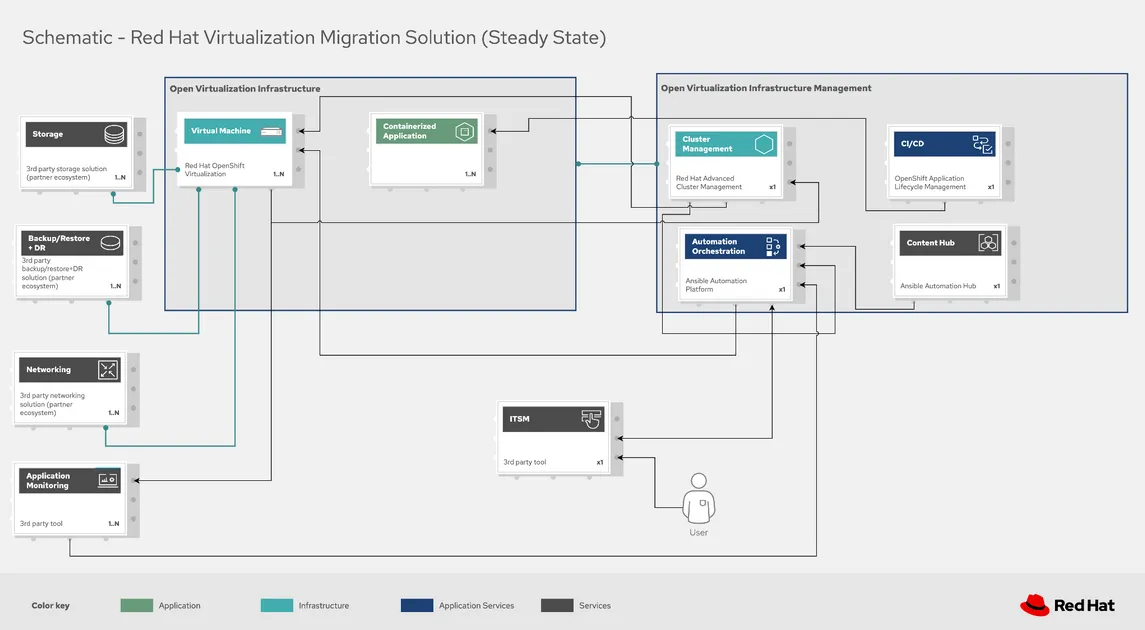The impact of recent virtual machine (VM) pricing changes has drastically increased the cost of virtualization, creating uncertainty and risks for many businesses. Inherent vendor lock-in has created critical IT dependency and interoperability issues, where the over-reliance on proprietary IT tools has stifled new use case adoption—use cases like AI that are bringing more, new workloads into existing virtualization infrastructure.
But migrating from traditional virtualization platforms and modernizing the virtualization architecture for continuous innovation and efficiency needs a deliberate approach. One that involves managing virtualization migration with flexibility and choice, with a proven path to infrastructure and application modernization and AI readiness.
When looking for an alternative virtualization platform to help lower their total cost of ownership (TCO), IT leaders are already struggling to get ahead of their accumulated tool sprawl and technical debt. This is especially true when running legacy applications on VMs alongside containerized applications that take advantage of new cloud-native technologies.
Red Hat’s open virtualization infrastructure can help VM administrators more quickly and easily rehost existing and new VMs with less risk of business disruption. This platform also helps businesses avoid the heavy switching costs and long onboarding times when they are ready to modernize their applications and add new capabilities like AI.
With only one platform to maintain, organizations do not need a large variety of skill sets and administration can be streamlined. It also means less exposure to potential attacks as well as being able to design and deploy more robust and focused security policies. Let’s take a look at how Red Hat helps reduce complexity when migrating VMs from Day 0 into Day 1 and 2.
Isolate and mitigate migration risks early
Businesses are spending more time today just maintaining, patching and updating their VM sprawl. Being able to migrate VMs off their current platform involves VM administrators being able to test and execute VM migrations with a phased approach. Intricate planning is needed to assess dependencies and prioritize workloads, with the hope of discovering any blindspots and hidden costs well before the actual migration.

At the bottom of Figure 1 we can see the initial environment with legacy applications running on VMs. At the top is the target platform where those applications run on the VMs that have been migrated using the assets in the migration factory (which we will discuss in more detail shortly), side-by-side with containerized applications. This platform and the applications are managed using automation at scale.
Some organizations might be concerned about switching costs when migrating, the potential complexity of onboarding the staff to the new platform and service downtime during migration. To address these concerns, Red Hat provides the migration assessment (one of the components of the migration factory), an engagement where all workloads running on VMs are thoroughly analyzed, and a detailed plan for phased migration is developed. Red Hat also offers a training program and certification so VM administrators can more quickly get up to speed.
Once the migration plan has been established, the actual process is carried out following whatever timelines suit the organization. The migration solution is called Red Hat migration toolkit for virtualization. Automation is used to migrate the VMs in batches and to run post-migration tasks to make sure their performance is optimal for the workloads that will run on them, all while helping to minimize downtime.

In the next diagram we can see a more detailed view of the migration process.
Automate and orchestrate migration at scale
To leverage the benefits of an alternative VM platform organizations have to learn and adapt to the nuances of a new deployment mode. This includes addressing configuration complexities and provisioning challenges, and VM users who do not have the time to learn new tooling will find their productivity impacted.

The platform underlying Red Hat’s open virtualization infrastructure is Red Hat OpenShift Virtualization, and automation is provided by Red Hat Ansible Automation Platform. This extracts all the information and configuration details from the source VMs and network switches and feeds them to the Migration Toolkit for Virtualization.
Additionally, thanks to Red Hat’s large partner ecosystem, organizations have a wide variety of options for storage, networking, backup/restore and disaster recovery.
But migration is only the beginning. The larger and more complicated part is the day-to-day management of the platform (Day 2 operations), where automation also plays a key role.
Safeguarding operations for business continuity
Businesses need to anticipate issues that could result in service downtimes, but operating diverse workloads across different target environments makes it challenging to monitor VMs for high availability. Fragmented visibility and manual context switching has slowed down resolution times for VM administrators trying to understand the health and performance of their IT environment.

Administrators also benefit from consolidating on one platform because they have a single pane of glass for monitoring their entire environment instead of having to divide their attention between a number of different tools. They are also able to use a more cloud-native approach to manage their VMs. This can result in a lower TCO thanks to the flexibility, scalability and resilience of this approach, as VMs can be included in DevSecOps and GitOps pipelines.
In Figure 4 we can see how the platform can be managed using Red Hat Advanced Cluster Management for Kubernetes to check if the components deployed on OpenShift are in the desired state and, if they are not, Ansible Automation Platform will correct that using the automation assets in the customer’s Ansible Automation Hub. This is a self-healing infrastructure since the events that happen in the platform trigger the adequate remediation actions. Additionally, OpenShift application lifecycle management provides continuous integration / continuous delivery (CI/CD) techniques for VMs and the rest of applications running on it.
Another benefit of this solution is that it provides self-service capabilities. For example, developers that need a VM for testing, can create a ticket in the IT service management (ITSM) tool the company uses and that can trigger the automatic provisioning of the resources they need. Once they are done with testing, the VM can be automatically deleted and the resources freed up.
Wrap up
Red Hat’s open virtualization infrastructure allows customers to migrate and run their VMs alongside cloud-native applications using modern technologies that are continuously monitored to improve data integrity and compliance. It reduces the risk of human error and simplifies tasks across the entire lifecycle of the workloads (Day 0 planning, Day 1 deployment and Day 2 operations) because it uses automation at scale. Its security features are also enterprise grade—starting from the immutability of Red Hat Enterprise Linux CoreOS and the granularity of SELinux to OpenShift’s role-based access control (RBAC) and the capabilities of Red Hat Advanced Cluster Security for Kubernetes.From this unified platform, technical leaders can extend their existing IT investments to a modern virtualization architecture as their business requirements change.
Check out this demo to see how this solution works. Take also a look at the Virtualization Migration Solution architecture to learn more, and visit Red Hat Architecture Center for many other topics and use cases.
執筆者紹介
Ricardo Garcia Cavero joined Red Hat in October 2019 as a Senior Architect focused on SAP. In this role, he developed solutions with Red Hat's portfolio to help customers in their SAP journey. Cavero now works for as a Principal Portfolio Architect for the Portfolio Architecture team.
Collin enjoys helping Agile developers plan, code, test, build and deploy quality digital experiences. He has scaled DevOps teams for continuous testing and automating application releases in that time. All the while monitoring and troubleshooting IT service health for SREs in production, and enabling ITOps teams to bridge and broker for hybrid cloud services.
類似検索
チャンネル別に見る
自動化
テクノロジー、チームおよび環境に関する IT 自動化の最新情報
AI (人工知能)
お客様が AI ワークロードをどこでも自由に実行することを可能にするプラットフォームについてのアップデート
オープン・ハイブリッドクラウド
ハイブリッドクラウドで柔軟に未来を築く方法をご確認ください。
セキュリティ
環境やテクノロジー全体に及ぶリスクを軽減する方法に関する最新情報
エッジコンピューティング
エッジでの運用を単純化するプラットフォームのアップデート
インフラストラクチャ
世界有数のエンタープライズ向け Linux プラットフォームの最新情報
アプリケーション
アプリケーションの最も困難な課題に対する Red Hat ソリューションの詳細
オリジナル番組
エンタープライズ向けテクノロジーのメーカーやリーダーによるストーリー
製品
ツール
試用、購入、販売
コミュニケーション
Red Hat について
エンタープライズ・オープンソース・ソリューションのプロバイダーとして世界をリードする Red Hat は、Linux、クラウド、コンテナ、Kubernetes などのテクノロジーを提供しています。Red Hat は強化されたソリューションを提供し、コアデータセンターからネットワークエッジまで、企業が複数のプラットフォームおよび環境間で容易に運用できるようにしています。
言語を選択してください
Red Hat legal and privacy links
- Red Hat について
- 採用情報
- イベント
- 各国のオフィス
- Red Hat へのお問い合わせ
- Red Hat ブログ
- ダイバーシティ、エクイティ、およびインクルージョン
- Cool Stuff Store
- Red Hat Summit


